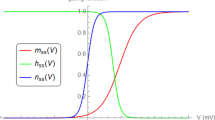Abstract
During prolonged activity the action potentials of skeletal muscle fibres change their shape. A model study was made as to whether potassium accumulation and removal in the tubular space is important with respect to those variations. Classical Hodgkin-Huxley type sodium and (potassium) delayed rectifier currents were used to determine the sarcolemmal and tubular action potentials. The resting membrane potential was described with a chloride conductance, a potassium conductance (inward rather than outward rectifier) and a sodium conductance (minor influence) in both sarcolemmal and tubular membranes. The two potassium conductances, the Na-K pump and the potassium diffusion between tubular compartments and to the external medium contributed to the settlement of the potassium concentration in the tubular space. This space was divided into 20 coupled concentric compartments. In the longitudinal direction the fibre was a cable series of 56 short segments. All the results are concerned with one of the middle segments. During action potentials, potassium accumulates in the tubular space by outward current through both the delayed and inward rectifier potassium conductances. In between the action potentials the potassium concentration decreases in all compartments owing to potassium removal processes. In the outer tubular compartment the diffusion-driven potassium export to the bathing solution is the main process. In the inner tubular compartment, potassium removal is mainly effected by re-uptake into the sarcoplasm by means of the inward rectifier and the Na-K pump. This inward transport of potassium strongly reduces the positive shift of the tubular resting membrane potential and the consequent decrease of the action potential amplitude caused by inactivation of the sodium channels. Therefore, both potassium removal processes maintain excitability of the tubular membrane in the centre of the fibre, promote excitation-contraction coupling and contribute to the prevention of fatigue.
Similar content being viewed by others
Author information
Authors and Affiliations
Additional information
Received: 5 May 1998 / Revised version: 27 October 1998 / Accepted: 19 January 1999
Rights and permissions
About this article
Cite this article
Wallinga, W., Meijer, S., Alberink, M. et al. Modelling action potentials and membrane currents of mammalian skeletal muscle fibres in coherence with potassium concentration changes in the T-tubular system. Eur Biophys J 28, 317–329 (1999). https://doi.org/10.1007/s002490050214
Issue Date:
DOI: https://doi.org/10.1007/s002490050214




